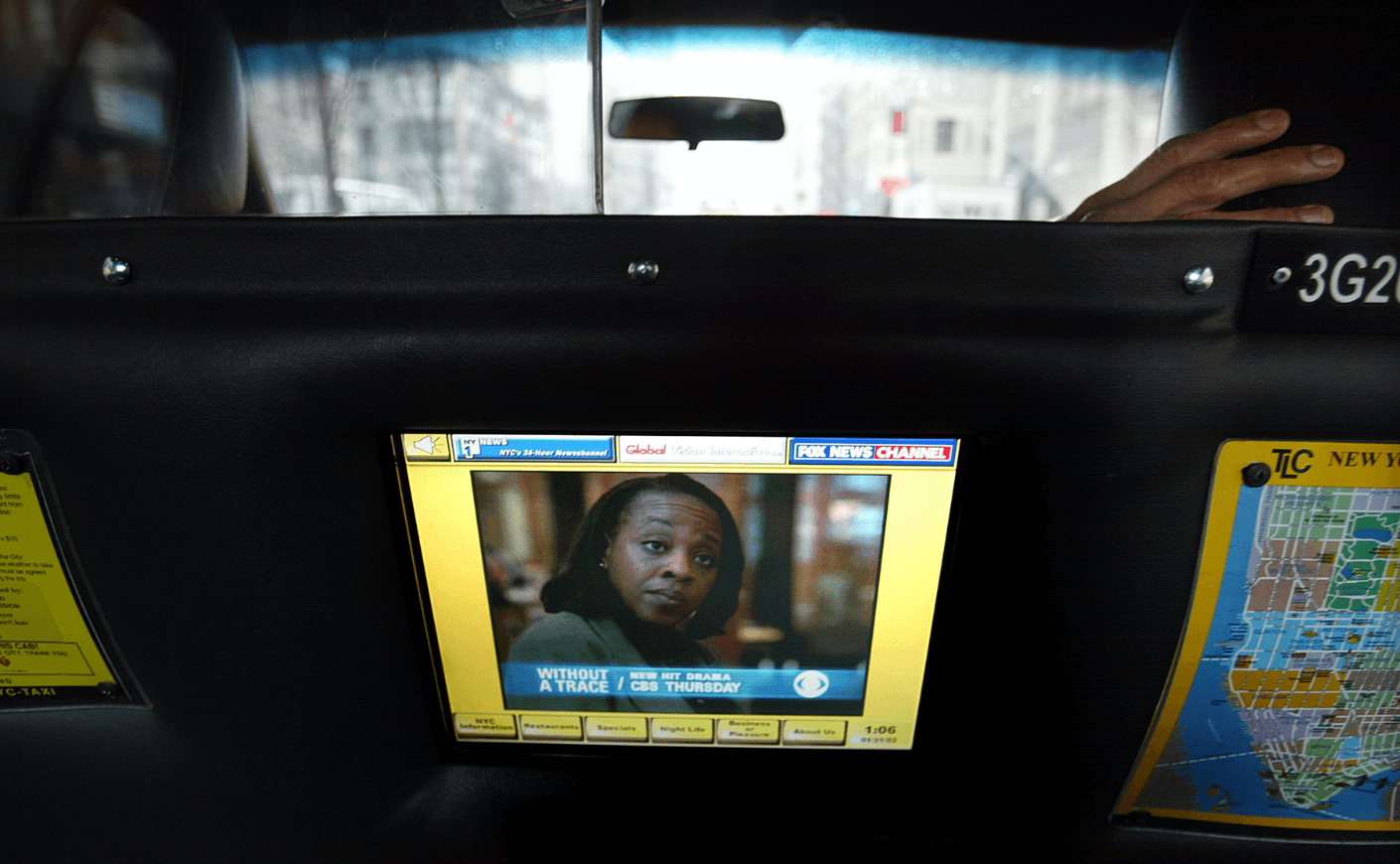The backseat of a cab might not seem like a battleground for political messaging, but that may be starting to change. Right-leaning news outlet Newsmax Media is teaming up with Curb, which bills itself as the country’s “largest taxi video network,” to stream its programming on thousands of taxi screens nationwide.
For more than two decades, so-called “Taxi TV” has helped shape the in-vehicle, “digital out-of-home” ad space — pioneering video campaigns that reach riders where they are. According to Curb, it operates across more than 15,000 screens across 65 U.S. markets, generating over 2.3 billion annual impressions in what it describes as a “uniquely captive environment.”
Now, that platform is becoming a new distribution channel for partisan media.
While Newsmax touts itself as the fourth-highest-rated cable news network in the U.S., public awareness of the President Trump-endorsed outlet remains far lower than that of other conservative-leaning networks. According to Pew Research Center, 57 percent of adults don’t know enough about Newsmax to say whether it’s part of the mainstream media — a stark contrast with the 73 percent who view Fox News as squarely within that category.
That lower profile is part of what makes this new distribution channel so strategically valuable for Newsmax — it puts the conservative network in front of riders who may not otherwise seek it out. And now, that strategy is taking shape inside the backseat of a cab. Here’s how the partnership works and why it matters.
What the NewsMax/Curb deal entails
Curb rolled out the partnership late last month, describing it as part of the company’s goal to offer “high-quality content that enhances the rider experience.” In a statement to Katie Couric Media, the company said its partnerships “are built around commercial alignment and mutual business goals,” adding that, “like other streaming and media platforms, we work with a range of content providers across categories.”
The deal inserts Newsmax segments into Curb’s rotating mix of weather, entertainment, lifestyle, and viral TikTok clips. All content, Curb says, must meet strict internal standards as well as Federal Communications Commission and local regulations.
“All content must comply with Curb’s strict internal standards as well as FCC and local advertising regulations,” the company noted. “We prohibit explicit, violent, or inappropriate material and require all news programming to be factually accurate and suitable for a broad audience — similar to network or airport TV standards.”
Curb emphasized that it oversees the platform, but does not make editorial judgments about political content that appears there.
“Partners like Newsmax are responsible for the programming they provide within those guidelines,” the company’s statement read. “Both sides collaborate to deliver an engaging rider experience, but Curb remains a neutral publisher and platform provider.”
The company also noted that riders have control over what they see: All video content is clearly branded with its source, and passengers can easily mute or switch off the screens if they choose.
A shift in public information spaces
Media experts say that the deal raises bigger questions about how partisan news is extending its reach into everyday spaces.
“Curb itself describes cab riders as a captive audience: That’s how they sell it to content producers and advertisers,” Keith J. Bybee, a professor of law and political science at Syracuse University told us. “You can’t just dive out of the cab if you don’t like what’s on the screen. It’s one more step in folding partisan outlets into the fabric of everyday spaces.”
While some riders may tune out or scroll on their phones, others may not immediately recognize the political leanings of the content they’re seeing.
“It’s not immediately clear that everybody inside the cab will know the political valence of the coverage,” Bybee said. “If you’re unaware, you default to the presumption that it’s just objective reporting and you’re more likely to accept it as fact.”
A changing definition of “mainstream media”
Bybee noted that the partnership reflects a larger trend in which the boundaries between neutral and partisan media are increasingly blurred.
“What this signals is that the definition of what constitutes a ‘conventional news organization’ is changing to include explicitly partisan outlets — accepted without concern or question,” he said.
But Bybee added that this shift isn’t exactly new. “We’re increasingly living in a media environment that looks a lot like the 19th century, when all news was partisan,” he said. “The best thing consumers can do is know the angle of the outlet they’re getting information from — so they can triangulate and think critically.”
Curb, meanwhile, says its role as a video delivery system isn’t about politics at all — it’s about running a platform. It broadcasts the content, but doesn’t create it.
“As a publisher, we do not censor media or make editorial judgments,” they wrote in an emailed statement. “Our role is to provide a compliant, commercially viable platform, not to shape viewpoints. Like any other media network, our decisions are business-driven. We welcome any content provider whose programming and business goals align with ours.”
What’s at stake
While Newsmax is a less-widely recognized name than Fox News in the right-wing media space, the partnership gives it access to a broader, more general audience, including younger riders who may not actively seek out political content.
“There’s an important point here about the necessity of critical news consumption,” Bybee said. “It’s always a good idea to maintain a healthy skepticism of anything you see — whether it’s on your phone, in a paper, or on a taxi cab screen. That’s never been more important than today.”









